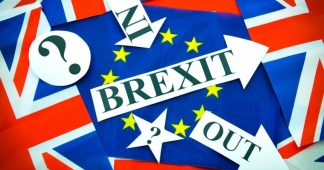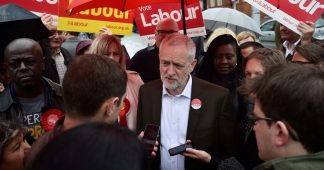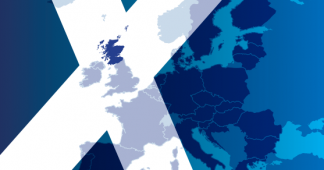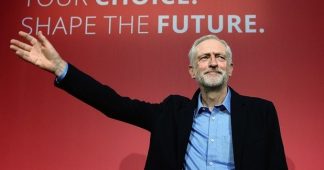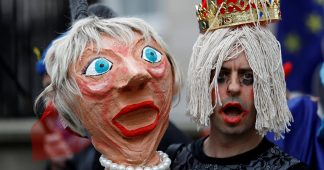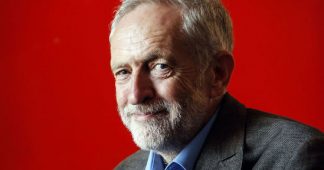Following the recent local government elections in Scotland, the Conservative Party of Prime Minister Theresa May is now the second largest after the Scottish National Party (SNP).
The Tories won 276 of 1,227 seats, an increase of 161. Their share of the vote almost doubled from 13 to 25 percent. This was not restricted to wealthier areas. Among those areas returning Tory councillors were Shettleston in Glasgow and Ferguslie Park in Paisley—both among the poorest areas in Britain.
How is this to be explained?
While the election took place amid sharply deepening austerity, with the potential break-up of both the European Union (EU) and the United Kingdom looming, the main issue fought out in Scotland was whether another referendum on Scottish independence should be held. The last referendum was held in 2014, with the No to independence campaign winning with a 10 percent margin of victory.
Immediately before May’s triggering of Article 50, paving the way for British departure from the EU, Scottish First Minister and SNP leader Nicola Sturgeon announced plans for a new referendum sometime in 2018 or 2019. Sturgeon’s decision was in large part an attempt to capitalise on the 2016 Brexit referendum vote, with Scotland supporting remaining in the EU by 63 percent, in a dramatic reversal of the vote in England. It followed repeated rebuffs from the British government over the SNP’s proposals to ensure, on behalf of Scottish-based business, continued access to the European Single Market in any negotiations with the EU.
Sturgeon anticipated that calling a new poll would strengthen her electoral position, while giving the Scottish government leverage over the terms of Brexit. The manoeuvre failed. Although the SNP won the local election by a substantial margin, it was not the resounding triumph its leadership anticipated. The party lost control of Dundee and did not win an overall majority in Glasgow, Scotland’s largest city.
Compared with the last local authority elections in 2012, the SNP’s share of the vote held at 32 percent. But compared to the general election of 2015, where the party won over 50 percent of the vote, ground was lost. Opinion polls suggest that the SNP could lose around seven of its 56 Westminster seats to the Tories in the June 8 general election.
A number of processes are at work.
Underpinning the Tory successes is the continuing decline of the Labour Party. In 1999, Labour controlled 17 of 32 local authority areas with 509 seats out of 1,222. After this month’s local elections, Labour can only exercise any power in coalition with its rivals and holds only 262 seats out of 1,227. Labour’s collapse in Scotland has been long in the making. The Scottish party supported the Blairites in ditching whatever remained of Labour’s reformist past, and provided no small number of its leading personnel, including two Labour chancellors, Alastair Darling and Gordon Brown. In 2007, Brown replaced Tony Blair as prime minister.
In local government, the party pioneered the shift to privatisation by transferring services to “Arms Length External Organisations” (ALEOs). These semi-private outfits, generally controlled by figures close to the local authority, can raise capital, hire and fire workers and reduce their conditions in line with the financial requirements of the local authority. Both the ALEOs and the top local authority posts provide an extremely comfortable living for a small number of officials close to the party in power, while vicious cuts are imposed year after year.
Previously, the SNP was the almost exclusive beneficiary of disaffection with Labour. But this is now changing.
In power in Holyrood for 10 years, the SNP has agreed to all the local government cuts demanded by Westminster, through year on year freezes on council tax bills. In the local authorities it controls, it has directly implemented cuts. In Dundee, run by the SNP until last week, some £16 million will be cut from the budgets for vital services following £23 million last year. At the same time, council tax bills are set to rise by 3 percent. In taking over control of Glasgow from Labour, the SNP will undoubtedly pursue identical policies at the expense of the working population.
Faced with the betrayal of their social aspirations by the SNP and Labour, and confronting nothing but the prospect of further cuts whichever party of the regional elite is in power, the majority, 53 percent, did not vote at all.
But under conditions where all parties are clearly lined up against workers’ interests, the national question, Scottish or British, is coming to dominate politics for a section of workers. Under Scottish leader Ruth Davidson, the Tories have aggressively targeted the SNP on this issue. Davidson fought the election by trumpeting she is leading “Scotland’s fightback against the SNP” and vehemently opposes another independence referendum. Labour, under Jeremy Corbyn, has been unable to take a clear position. Corbyn said in March that he was “absolutely fine” with a poll, before stating, a day later, that he opposed one. Labour’s hapless leader in Scotland, Kezia Dugdale, has been just as equivocal.
Among some Labour supporters, Davidson’s claim to be against “division” likely struck a chord. Most of the seats gained by the Conservative and Unionist Party were taken from Labour by winning votes from those who are against erecting a border between Scotland and England with everything that entails.
Among those elected as Tories were formers supporters of the British National Party, admirers of racist Tory politician Enoch Powell and current members of the Protestant Orange Order. Leader of the Orange Order in Scotland, Jim McHarg, told the Herald that its members elected as councillors, Labour or Tory, “could do no harm to the Unionist people.”
Full responsibility for the sway held by competing nationalisms over political life lies with the pseudo-left tendencies, which for decades have portrayed Scottish independence as a left-wing and progressive response to Tory rule. This embrace of nationalism makes them the de facto advocates of divisions in the working class, not only between those on Scotland and England but within Scotland itself.
They act openly as a loyal ginger group, urging the SNP to take a harder line on independence. The Scottish Socialist Party has urged the snap general election to be run as “The Independence Election,” urging “Corbyn voters in Scotland to recognise and seize the profound opportunity independence offers here”—a fairly unambiguous call for a vote for the SNP. They solidarise themselves with SNP leader Alex Salmond, who has criticised Sturgeon for not focusing sufficiently on independence, declaring, “We are bound to say we agree with Alex. We realise Sturgeon’s reluctance to follow his advice since a third of SNP voters don’t support independence. But putting seats before causes is extremely short-sighted.”
They conclude with the pathetic declaration, “We will therefore press the SNP to put just such an unequivocal commitment to independence in it’s [sic] manifesto. And we will criticise them if they do not.”
A recent statement from the Socialist Party Scotland (SPS)—allies of the Socialist Party of England and Wales—implicitly welcomes the possible impact of a Tory general election victory, suggesting, “If the Tories were to win an increased majority in June, this would add further impetuous [sic] to demands for a second referendum and support for Scottish independence. It could also set a collision course between the Scottish Government and Westminster over that issue.”
